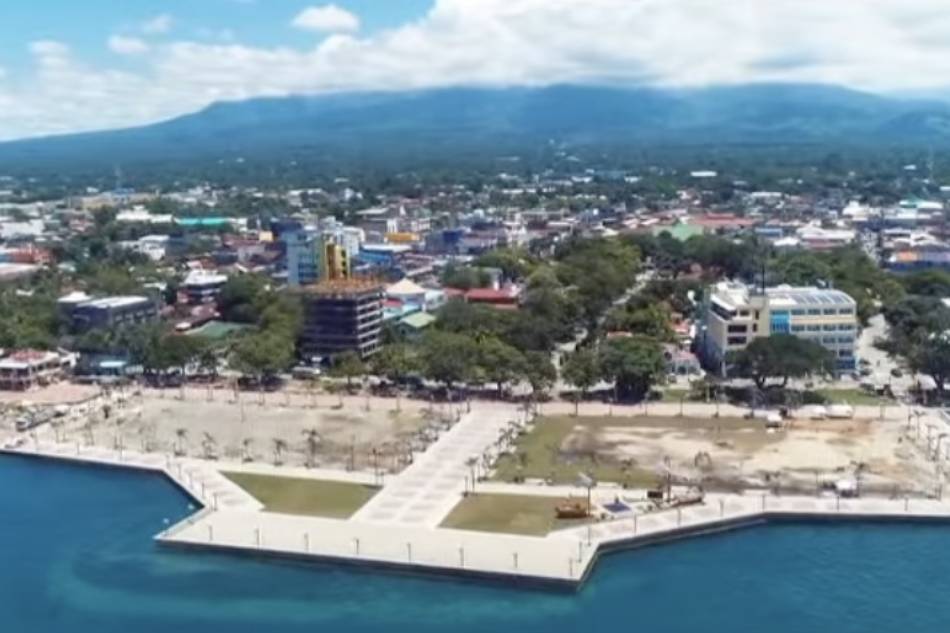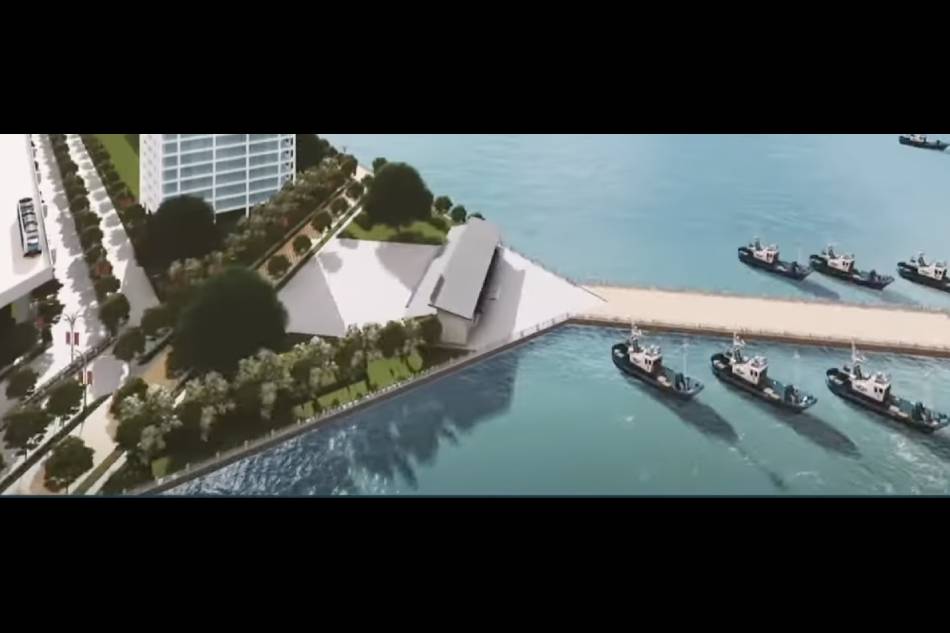As big as 10 Lunetas, 4,000 basketball courts: What is the P23-billion land reclamation project in Dumaguete?
ADVERTISEMENT

Welcome, Kapamilya! We use cookies to improve your browsing experience. Continuing to use this site means you agree to our use of cookies. Tell me more!
As big as 10 Lunetas, 4,000 basketball courts: What is the P23-billion land reclamation project in Dumaguete?
Job Manahan,
ABS-CBN News
Published Jul 16, 2021 07:56 PM PHT
MANILA - Various groups, sectors, including a diocese and a national scientist, have lent their voices to oppose a P23-billion planned land reclamation project in Dumaguete City in Negros Oriental, as the project would supposedly destroy the city’s protected marine life and diversity.
MANILA - Various groups, sectors, including a diocese and a national scientist, have lent their voices to oppose a P23-billion planned land reclamation project in Dumaguete City in Negros Oriental, as the project would supposedly destroy the city’s protected marine life and diversity.
The proposed 174 hectare land reclamation project fronting the city's shoreline, aims to build a 5G-ready “Smart City” under a private-public partnership. It also plans to build a coastal wastewater treatment facility/wave protection, esplanade, marina, modern ferry port and raw reclamation and horizontal development.
The proposed 174 hectare land reclamation project fronting the city's shoreline, aims to build a 5G-ready “Smart City” under a private-public partnership. It also plans to build a coastal wastewater treatment facility/wave protection, esplanade, marina, modern ferry port and raw reclamation and horizontal development.
Dumaguete City Mayor Felipe Antonio Remollo, in an interview on ANC earlier in the day, said the project would be "sustainable and a solution to the poverty of the people of Dumaguete and Negros Oriental."
Dumaguete City Mayor Felipe Antonio Remollo, in an interview on ANC earlier in the day, said the project would be "sustainable and a solution to the poverty of the people of Dumaguete and Negros Oriental."
Quezon City-based developer EM Cuerpo Inc. first submitted the “unsolicited proposal” to them on Nov. 15, 2019, he said in a press briefing on Wednesday.
Quezon City-based developer EM Cuerpo Inc. first submitted the “unsolicited proposal” to them on Nov. 15, 2019, he said in a press briefing on Wednesday.
ADVERTISEMENT
Remollo said although his city council approved the joint venture agreement or memorandum of understanding (MOU) with the developer, he has yet to sign it due to some issues from his constituents and concerned individuals who are “confused with the process.”
Remollo said although his city council approved the joint venture agreement or memorandum of understanding (MOU) with the developer, he has yet to sign it due to some issues from his constituents and concerned individuals who are “confused with the process.”
The local chief executive said during the briefing that the Public Private Partnership contract is different from the MOU, because in order for the contract to be signed, they have to get clearance from the Philippine Reclamation Authority (PRA) and the Department of Environment and Natural Resources (DENR).
The local chief executive said during the briefing that the Public Private Partnership contract is different from the MOU, because in order for the contract to be signed, they have to get clearance from the Philippine Reclamation Authority (PRA) and the Department of Environment and Natural Resources (DENR).
“After the signing of the agreement with the project proponent... this would be applied to the PRA and submit the necessary documents to [them] to require the city and the project proponent to go to the process in the DENR,” he explained.
“After the signing of the agreement with the project proponent... this would be applied to the PRA and submit the necessary documents to [them] to require the city and the project proponent to go to the process in the DENR,” he explained.
The DENR would require environment assessment, [environment compliance certificate] where the people… where there would be public consultations… this is a tedious process,” he added.
The DENR would require environment assessment, [environment compliance certificate] where the people… where there would be public consultations… this is a tedious process,” he added.
Stakeholders earlier said the local government did not inform them of the planned land reclamation project, which also has a devastating impact culturally and socially.
Stakeholders earlier said the local government did not inform them of the planned land reclamation project, which also has a devastating impact culturally and socially.
ADVERTISEMENT
The project would “directly destroy, literally bury, the few remaining coral reef, seagrass and soft-sediment ecosystems” in Dumaguete -- the resources that most fisherfolk there rely on, Silliman University, which is based there, said in a statement.
The project would “directly destroy, literally bury, the few remaining coral reef, seagrass and soft-sediment ecosystems” in Dumaguete -- the resources that most fisherfolk there rely on, Silliman University, which is based there, said in a statement.
WATCH
Citing a study in 2020, the university pointed out that over 200 fish species in the area would be directly hit, more than half of which is important for the residents’ livelihood.
Citing a study in 2020, the university pointed out that over 200 fish species in the area would be directly hit, more than half of which is important for the residents’ livelihood.
“If the material will be dredged from deeper soft-sediment sites adjacent to the reclamation sites, construction will not only bury the remaining shallow marine ecosystems of Dumaguete but also destroy deeper marine ecosystems that support local fisheries,” it read.
“If the material will be dredged from deeper soft-sediment sites adjacent to the reclamation sites, construction will not only bury the remaining shallow marine ecosystems of Dumaguete but also destroy deeper marine ecosystems that support local fisheries,” it read.
The university also emphasized the role of marine protected areas (MPA) in the city which are situated along barangays Bantayan, Lo-oc, Mangnao and Banilad.
The university also emphasized the role of marine protected areas (MPA) in the city which are situated along barangays Bantayan, Lo-oc, Mangnao and Banilad.
Protected marine areas are relevant for sustaining the declining number of fish and the coral reefs’ biodiversity, Silliman explained in a separate note on its website.
Protected marine areas are relevant for sustaining the declining number of fish and the coral reefs’ biodiversity, Silliman explained in a separate note on its website.
ADVERTISEMENT
“The massive reclamation project will negatively impact these MPAs directly or indirectly. Some of these MPAs may even cease to exist… It will be a disgraceful act considering that the MPA movement in the Philippines, known throughout the world for its successes in the past 40 years, has its roots in Dumaguete City at Silliman University,” according to the statement.
“The massive reclamation project will negatively impact these MPAs directly or indirectly. Some of these MPAs may even cease to exist… It will be a disgraceful act considering that the MPA movement in the Philippines, known throughout the world for its successes in the past 40 years, has its roots in Dumaguete City at Silliman University,” according to the statement.
“Relocation, rehabilitation or reconstruction of the critical marine ecosystems that will be affected by this reclamation project is not feasible.”
“Relocation, rehabilitation or reconstruction of the critical marine ecosystems that will be affected by this reclamation project is not feasible.”
National Scientist Angel Alcala, who is a known figure for contributions in the field of biology and marine ecosystem, Silliman University President Dr. Betty Cernol-McCann, and environmental policy expert Ben Malayang III were among the statement’s signatory.
National Scientist Angel Alcala, who is a known figure for contributions in the field of biology and marine ecosystem, Silliman University President Dr. Betty Cernol-McCann, and environmental policy expert Ben Malayang III were among the statement’s signatory.
‘TOMB FOR MARINE ECOSYSTEMS’
Land reclamation, most especially for developing infrastructures, is the process of creating land from the sea by filling that area with cement, heavy rocks, clay and soil.
Land reclamation, most especially for developing infrastructures, is the process of creating land from the sea by filling that area with cement, heavy rocks, clay and soil.
According to a study in 2019, 76 land reclamation projects on areas in West Coast Peninsular Malaysia had an “adverse impact” on fish supplies. Aside from this, mercury levels in the water rose significantly, higher than the safe levels recommended.
According to a study in 2019, 76 land reclamation projects on areas in West Coast Peninsular Malaysia had an “adverse impact” on fish supplies. Aside from this, mercury levels in the water rose significantly, higher than the safe levels recommended.
ADVERTISEMENT
This is why the study’s authors noted the importance of assessing the impact of these reclamation projects to the area’s biodiversity.
This is why the study’s authors noted the importance of assessing the impact of these reclamation projects to the area’s biodiversity.
Critics of the project also said that 84 percent of the fish in the city’s “deeper ecosystems” play a huge part in the subsistence of the local fishermen.
Critics of the project also said that 84 percent of the fish in the city’s “deeper ecosystems” play a huge part in the subsistence of the local fishermen.
Even if the city government and the developer propose to rehabilitate the coral reefs, the damage would be irreversibile and sustaining it would cost much more.
Even if the city government and the developer propose to rehabilitate the coral reefs, the damage would be irreversibile and sustaining it would cost much more.
“A recent study showed that the vast majority of coral reef rehabilitation efforts around the world have not been able to scale up to the size of actual coral reef ecosystems, in the order of hundreds to thousands of hectares. This is partly due to the monetary costs involved.”
“A recent study showed that the vast majority of coral reef rehabilitation efforts around the world have not been able to scale up to the size of actual coral reef ecosystems, in the order of hundreds to thousands of hectares. This is partly due to the monetary costs involved.”
For ecologist Dr. Rene Abesamis, the Dumaguete project is a “tomb for marine ecosystems” because of the danger it poses.
For ecologist Dr. Rene Abesamis, the Dumaguete project is a “tomb for marine ecosystems” because of the danger it poses.
ADVERTISEMENT
Abesamis also said the project could impact the nearby Tañon Strait, a national marine protected area where about 14 species of marine mammals pass through the waters of Dumaguete.
Abesamis also said the project could impact the nearby Tañon Strait, a national marine protected area where about 14 species of marine mammals pass through the waters of Dumaguete.
“I think we really need to avoid this because there is no doubt in my mind that is going to be a monumental ecological disaster…we have to understand how big this is. According to the press release, its 174 hectares, that’s equivalent to maybe 4,000 basketball courts, 10 Lunetas,” Abesamis noted in an interview on ANC.
“I think we really need to avoid this because there is no doubt in my mind that is going to be a monumental ecological disaster…we have to understand how big this is. According to the press release, its 174 hectares, that’s equivalent to maybe 4,000 basketball courts, 10 Lunetas,” Abesamis noted in an interview on ANC.
“The image that the public information office released suggests its about 7 kilometers—that’s roughly the distance from Cubao to Guadalupe on EDSA—and Dumaguete is not a very big city. It doesn’t have a big coastline. It’s about 8.5 km long and this project is a massive project, it will occupy about 85 percent of that,” he pointed out.
“The image that the public information office released suggests its about 7 kilometers—that’s roughly the distance from Cubao to Guadalupe on EDSA—and Dumaguete is not a very big city. It doesn’t have a big coastline. It’s about 8.5 km long and this project is a massive project, it will occupy about 85 percent of that,” he pointed out.
While there is no information yet on where the soil would be sourced for the project, he said that some concerned engineers have given rough estimates that it would be needing around 80 million cubic meters.
While there is no information yet on where the soil would be sourced for the project, he said that some concerned engineers have given rough estimates that it would be needing around 80 million cubic meters.
The Diocese of Dumaguete also expressed concern on the project and urged the local government to hold a dialogue with the stakeholders.
The Diocese of Dumaguete also expressed concern on the project and urged the local government to hold a dialogue with the stakeholders.
ADVERTISEMENT
“While we acknowledge the intention…. to promote economic, social, and political development, we strongly believe that massive projects like the one stated above must also consider the scientific and environmental implications, not to mention its impacts on the cultural and moral life of the people in the local community,” the diocese said on Jul. 12.
“While we acknowledge the intention…. to promote economic, social, and political development, we strongly believe that massive projects like the one stated above must also consider the scientific and environmental implications, not to mention its impacts on the cultural and moral life of the people in the local community,” the diocese said on Jul. 12.
‘I AM NOT ONLY MAYOR FOR THE ENVIRONMENTALISTS’
Remollo, who said he is not related to any of the project’s developers, maintained that he only cares for his constituents’ welfare.
Remollo, who said he is not related to any of the project’s developers, maintained that he only cares for his constituents’ welfare.
It will also be challenging to construct buildings and condominiums in Dumaguete as most of the properties there are owned by families. He also cited the long expropriation process which could take years.
It will also be challenging to construct buildings and condominiums in Dumaguete as most of the properties there are owned by families. He also cited the long expropriation process which could take years.
Moreover, his city does not have enough funds to buy the said properties from its owners.
Moreover, his city does not have enough funds to buy the said properties from its owners.
“I am not only mayor for the environmentalists, or a particular institution or for the rich people living along the boulevard. I am mayor for 150,000 residents, 70 percent of those are the poor, jobless,” he said, outlining the infrastructure blueprint of the project.
“I am not only mayor for the environmentalists, or a particular institution or for the rich people living along the boulevard. I am mayor for 150,000 residents, 70 percent of those are the poor, jobless,” he said, outlining the infrastructure blueprint of the project.
ADVERTISEMENT
WATCH
Consultations will also happen once the project’s proponents finalize the detail of the engineering plans, he said, noting that they are currently talking with the stakeholders.
Consultations will also happen once the project’s proponents finalize the detail of the engineering plans, he said, noting that they are currently talking with the stakeholders.
“All I committed in the MOU, all their opposition, position papers will be brought to… PRA, the DENR, for open public discussion… I do not really care if it will not push through. I am from Dumaguete, I am as concerned with the environment, let be a healthy discussion, debate with the concerned government agencies."
“All I committed in the MOU, all their opposition, position papers will be brought to… PRA, the DENR, for open public discussion… I do not really care if it will not push through. I am from Dumaguete, I am as concerned with the environment, let be a healthy discussion, debate with the concerned government agencies."
Remollo encouraged other stakeholders to come forward with their inputs as this project is "open, this is not a done deal." He said he will "personally hand over to the deciding authorities the oppositions to show his transparency.
Remollo encouraged other stakeholders to come forward with their inputs as this project is "open, this is not a done deal." He said he will "personally hand over to the deciding authorities the oppositions to show his transparency.
Online petitions have been made to oppose the project, created by concerned citizens and the Silliman University.
Online petitions have been made to oppose the project, created by concerned citizens and the Silliman University.
The one posted on Change.org titled “Save the Dumaguete Coastline; its Community and Biodiversity #NoTo174Dumaguete” already has over 13,000 signatures out of the 15,000 needed.
The one posted on Change.org titled “Save the Dumaguete Coastline; its Community and Biodiversity #NoTo174Dumaguete” already has over 13,000 signatures out of the 15,000 needed.
- With reports from Davinci Maru and TJ Billones, ABS-CBN News
Read More:
Land reclamation
Dumaguete City
EM Cuerpo Inc
Dumaguete City Mayor Felipe Antonio Remollo
Felipe Antonio Remollo
Silliman University
Dumaguete reclamation project
land reclamation project
ADVERTISEMENT
ADVERTISEMENT




